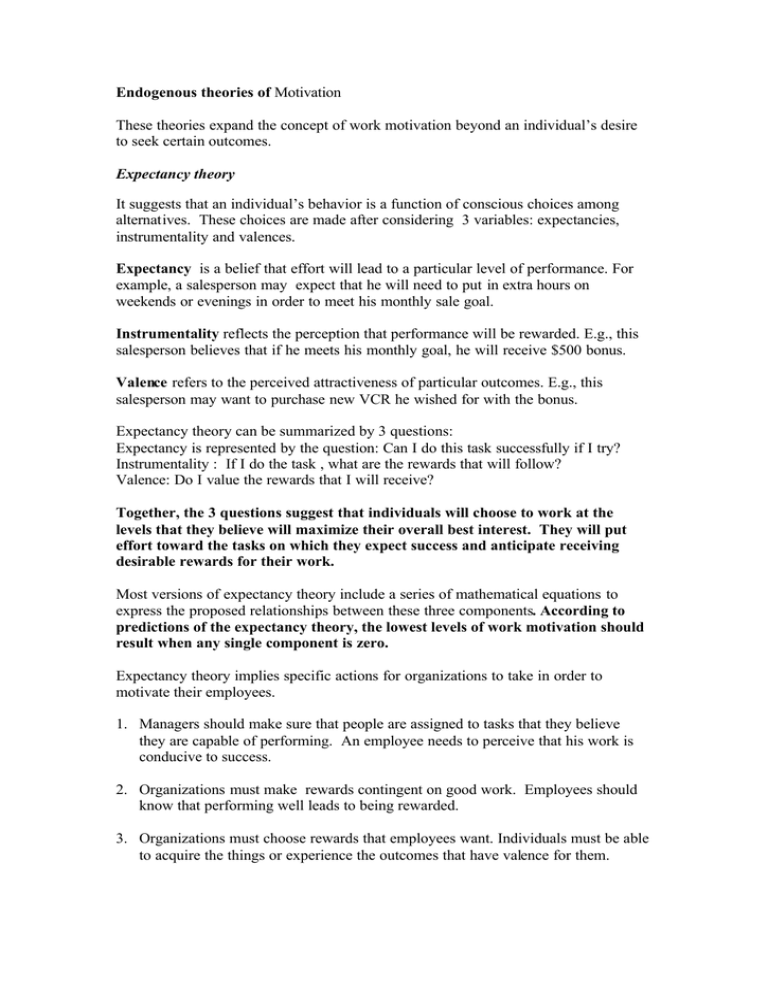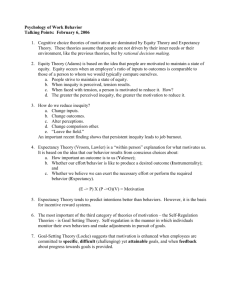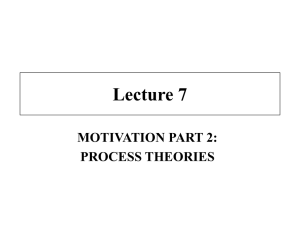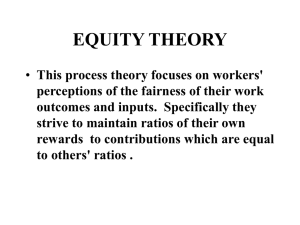Endogenous theories of to seek certain outcomes.
advertisement

Endogenous theories of Motivation These theories expand the concept of work motivation beyond an individual’s desire to seek certain outcomes. Expectancy theory It suggests that an individual’s behavior is a function of conscious choices among alternatives. These choices are made after considering 3 variables: expectancies, instrumentality and valences. Expectancy is a belief that effort will lead to a particular level of performance. For example, a salesperson may expect that he will need to put in extra hours on weekends or evenings in order to meet his monthly sale goal. Instrumentality reflects the perception that performance will be rewarded. E.g., this salesperson believes that if he meets his monthly goal, he will receive $500 bonus. Valence refers to the perceived attractiveness of particular outcomes. E.g., this salesperson may want to purchase new VCR he wished for with the bonus. Expectancy theory can be summarized by 3 questions: Expectancy is represented by the question: Can I do this task successfully if I try? Instrumentality : If I do the task , what are the rewards that will follow? Valence: Do I value the rewards that I will receive? Together, the 3 questions suggest that individuals will choose to work at the levels that they believe will maximize their overall best interest. They will put effort toward the tasks on which they expect success and anticipate receiving desirable rewards for their work. Most versions of expectancy theory include a series of mathematical equations to express the proposed relationships between these three components. According to predictions of the expectancy theory, the lowest levels of work motivation should result when any single component is zero. Expectancy theory implies specific actions for organizations to take in order to motivate their employees. 1. Managers should make sure that people are assigned to tasks that they believe they are capable of performing. An employee needs to perceive that his work is conducive to success. 2. Organizations must make rewards contingent on good work. Employees should know that performing well leads to being rewarded. 3. Organizations must choose rewards that employees want. Individuals must be able to acquire the things or experience the outcomes that have valence for them. Equity theory Equity theory explores the effect that social comparison between employees will have on individual’s performance. Equity theory explains that not only does the actual value of rewards matter, but so does the relative value when compared to the rewards received by co-workers. More specifically, equity theory suggests that individuals create a ratio of their inputs (effort, time, abilities) to their outcomes (pay, recognition, benefits) in order to determine the fairness of their rewards. Equity theory can be summarized by two equations: Equity occurs when Is/Os = Io/Oo Where: Is is the inputs for self Os are outcomes for self Io is the input of the other comparison individual Oo are the outcomes of the other comparison individual In contrast , inequity occurs when Is/Os > Io/Oo or Is/Os < Io/Oo If these ratios are the same, there is perceived equity and the employee is not motivated to change his inputs or outcomes in the situation. If these ratios are different, then the employee is motivated to restore equity. Inequity is perceived when individuals believe that they are under-rewarded relative to the other and when they perceive that they are over-rewarded relative to the other. Equity theory suggests that individuals may take a variety of actions in order to restore equity. 1. They may objectively change the inputs or outcomes for themselves. 2. They may objectively change the inputs or outcomes for the comparison individual. 3. They may psychologically change the inputs or outcomes for themselves. 4. They may psychologically change the inputs or outcomes for the comparison individual. 5. They may select a different comparison individual. 6. They may withdraw from the situation. The action chosen to restore equity will depend on the degree of perceived inequity, the constraints on the individual, and the individual’s perception about which action is most likely to restore equity. For example, a police officer might create her input to outcomes ratio by analyzing the hours that she puts in, the years she spent in school and training, her 4 years of experience on the job, and her perceived level of ability. She evaluates those inputs against the high risk in her job, her salary, the recognition she receives from the manager, and the relationships that she has with her co-workers on the police force. Having established this ratio, she may identify her partner as a relevant individual for comparison. She will attempt to assess his inputs: the hours that he puts in, his education, training and experience, and her perceptions of his ability. She will also attempt to estimate his outcomes: she may know what his salary is, she observes the recognition that he gets from the manager, understands the risk of his job, and observed his relationships with others on the police force. If she believes that her input to outcomes ratio is different from his, she will be motivated to establish equity. If the police officer finds that her partner has similar training and education, assumes that he has similar abilities and puts in similar hours, but finds that he is paid more, and notices that he receives more attention from the boss, she may take one of many possible actions. She may ask her supervisor for a raise and discuss her need for feedback (objectively increasing her outcomes). She could psychologically alter the outcomes by thinking differently bout them and deciding that she has better relationships with her co-workers that are very meaningful to her. She may reduce her input by working fewer hours or reducing her level of effort, or she may quit to look for another job in which she believes she will be treated equitably. Equity theory suggests that individuals will be motivated to restore equity when the ratios are unequal regardless of whether the discrepancy benefits the individual or not. In other words, it suggests that our police officer would also initiate change if she believes that she is overpaid in comparison to her partner (or if her partner is the one to discover the inequity, he will attempt to restore equity). Research on equity theory has consistently shown support for the theory under conditions of underpayment. Individuals typically reduce their input s in the form of quality or quantity for work. In contrast, the research is less conclusive under conditions of overpayment. Individuals do not consistently increase their quantity or quality of performance to compensate for the higher level of outcomes that they are receiving. Motivational Practices: Programs Used to Improve Performance In addition to developing theories and models to explain and predict the work performance level of employees, psychologists have used this understanding to create programs that can be implemented to improve the productivity of individual and organizations. Many organizations have turned to goal setting programs and the complex Management by Objective to enhance the performance of their employees. Goal setting programs are developed from the research on goal theory. These programs are applied to a variety of jobs including sales, management, technical, and clerical jobs, and have reported up to 10 to 25% improvement in performance. The outgrowth of goal setting as a motivational program has been the development of management by objectives, which has been shown to be most effective in enhancing organizational productivity when theories thorough support from upper- level management and when all individuals within the organization use this program. The program may be less effective when the practices are only applied at the middle and lower levels of organization and not to the top- level people. Other practical programs are incentives to facilitate improved performance among the employees. Many organizations have implemented group incentive plans because they are more easily administered and they encourage cooperation within work groups. These incentive programs effectively facilitate cooperation among workers and encourage peer pressure to improve services or productivity. Research on work motivation reveals a complex process and many of these theories can explain at least some observed work behavior. These motivational theories have led to the development of many practical motivational programs designed to improve services or productivity within organizations.






